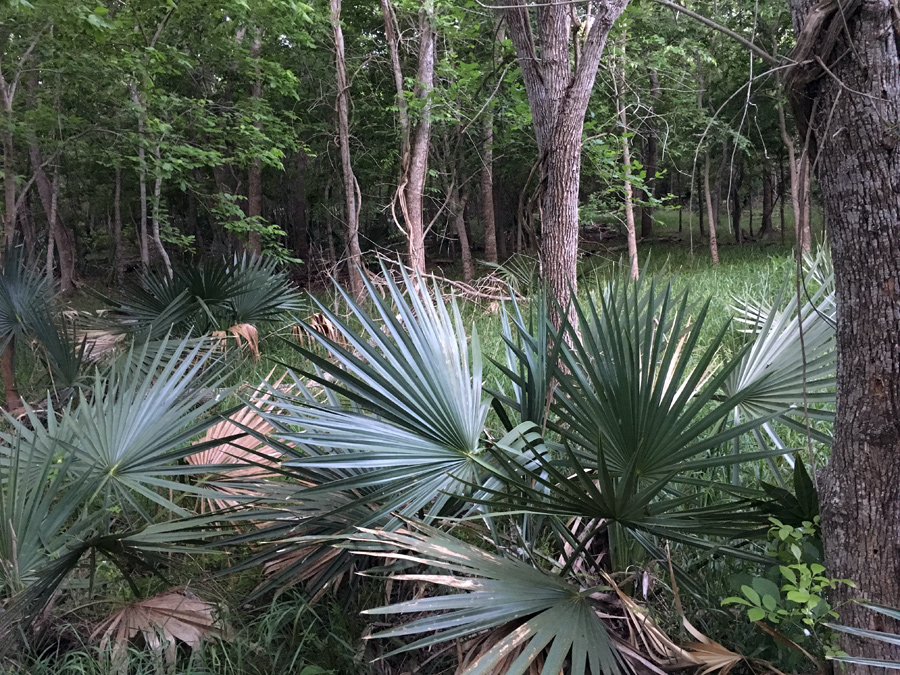
April 24, 2017
It’s said to be a dark, black thing; a thing that can blend so well into the murky bog that it’s virtually invisible. Known locally as the “Ottine Swamp Thing” or simply “The Thing,” this alleged cryptid falls somewhere between a Skunk Ape and something far more unexplainable. The creature has long been on my radar, but only recently did I get an opportunity to visit Ottine Swamp and delve more deeply into the details of this intriguing legend. Ottine Swamp itself is a 198-acre wetland located along the San Marcos River in South Central Texas. It sits on the edge of the small, unincorporated community of Ottine, and is part of the larger Palmetto State Park. Like the park, the swamp offers a unique habitat not typically found in Central Texas. This is due to the presence of dwarf palmetto (Sabal minor) and Spanish moss (Tillandsia usneoides) which are more commonly found further east along the Gulf Coast. Sulphur springs – known regionally as “Mud Boils” – were also present in the area until they dried up in the 1970s. But even today, the place oozes with a spooky, primordial atmosphere like a forgotten remnant of the Jurassic age. During daylight hours, it would not seem surprising if a dinosaur walked out of the thick palmettos. As nightfall approaches, the swamp takes on an even more mysterious appearance as the pointed fronds of the alien plants crouch among shaded bogs of standing water.

Ottine Swamp (photo by Lyle Blackburn)
Not surprisingly, Ottine is a place where legends have simmered and sightings of a strange swamp creature have been reported. The primary source for these accounts is the 1981 book, Ghost Stories of Texas, by Ed Syers. Within its pages, Syers recounts a conversation with a man name named Berthold Jackson, who tells of his own experiences with the Thing of Ottine Swamp along with several secondhand stories. Jackson – a Texas A&M University graduate engineer and skilled woodsman – claims he encountered the creature in the swamp on three occasions. He described it as being something of an ape-like entity, black or gray in color, four to eight feet in height, one hundred pounds or more in weight, extremely fast, and having footprints “like a small woman’s hand except it comes to a point at the base of the palm.” It also has a chilling cry which he describes as “somewhere between human and animal.” Jackson cannot provide further specifics on its anatomy, however, since he’s never actually laid eyes on it. This, he says, is because the Thing has the ability to render itself invisible or at least camouflage itself so well that only its movements can be seen as it stalks through the brush.

San Marcos River near Ottine Swamp (photo by Lyle Blackburn)
On one occasion, Jackson says he and a friend were hunting in the swamp at night when the creature got between them. “We could see the brush move,” he explained. They shined a carbide light directly at it, but could not see a thing; not even eyeshine. After it fled, they discovered significant snapped limbs which confirmed something large had come through. Jackson goes on to relay several similar accounts, including one in which three men were running a trotline one night when the creature stalked them. “The thing came along the bank,” Jackson recounted. “[T]hey could see those bloodweeds move as it followed.” Syers’ book details other accounts of a similar nature. In each case the witnesses knew they were being stalked by a creature, but could never quite see it clearly in the blackness of the swamp. In other instances, the creature was said to have scared campers and residents by grabbing car bumpers or shaking mobile homes in a violent manner. A number of the incidents took place at Lookout Hill near the entrance of the Palmetto State Park.
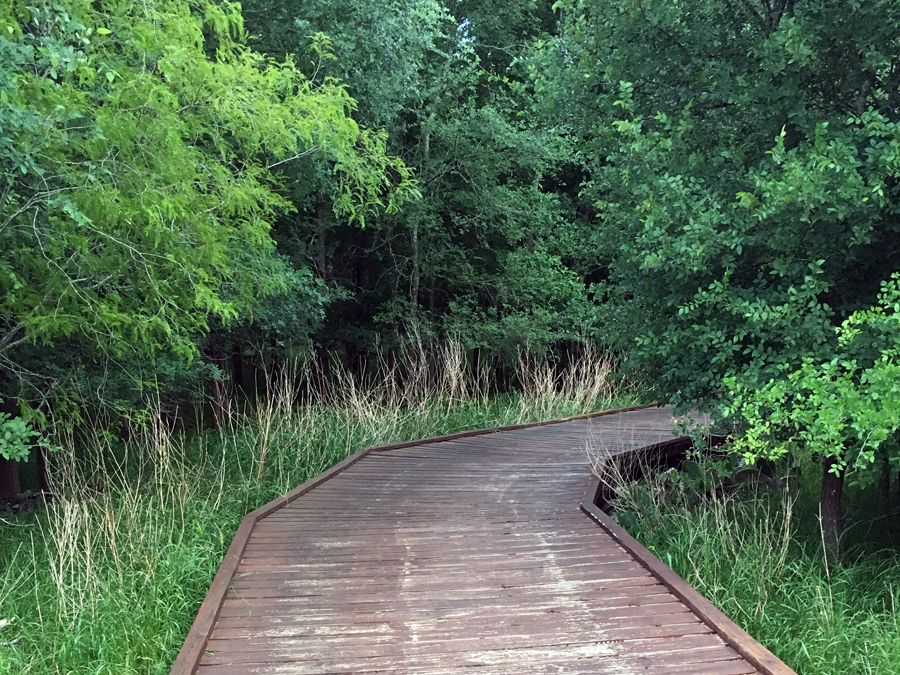
Bridge along the Ottine Swamp Trail (photo by Lyle Blackburn)
Given the vague descriptions, apparent powers of invisibility, and secondhand nature of most reports, the question as to whether this is/was a real creature or merely a legend is a pertinent one. The ability to be “invisible” certainly pushes it toward the realm of legend or at least supernatural, yet Jackson’s comparison to an “ape” brings up the possibility of a Bigfoot, perhaps one with an extraordinary knack for concealing itself among the palmettos. While South Central Texas in general would not be considered prime Bigfoot habitat, the possibility that one of these creatures could travel through the swamp or the winding woods along the San Marcos River is not out of the question. In fact, a couple reported seeing a “tall black ‘something’” along the Ottine Swamp Trail in June 2014. The thing was seen running very quickly and appeared to be something other than a person, deer, or hog. The sighting corresponded with the sound of a large, falling tree limb and a strange howl, both suggestive of purported Bigfoot activity. The report was submitted to the North American Wood Ape Conservancy (NAWAC) and subsequently investigated by longtime member Michael Mayes, who deemed the witnesses to be credible. After visiting Ottine Swamp myself, I can see how this environment could easily evoke tales of strange inhabitants and serve to conceal any large animals that may choose to pass through or take up residence. As I walked along the Ottine Swamp Trail at dusk, I caught a glimpse of a dark shape in the high grass about 60 yards away. At first I thought it was a rotting tree stump, but then it moved. As I looked more closely, I realized it was a feral hog. I also noticed four others standing nearby, foraging in the muddy bottoms. After a few moments they caught my scent and quickly bolted out of sight. While these were not apes or “monsters,” it was a good example of how difficult it would be to see any dark animal in those conditions. If the hog had never moved, I might have believed it was indeed a tree stump and simply walked on down the trail. Darkness was falling fast in the boggy bottoms, providing a perfect cover for all manner of creatures that may live within its depths.
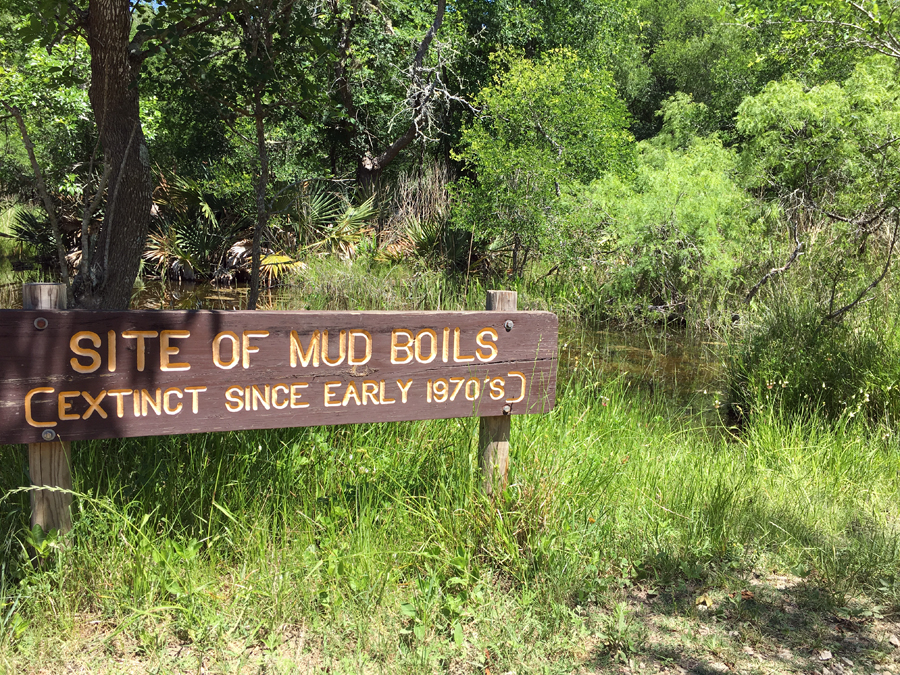
Site of a dormant Sulphur Spring or “Mud Boil” (photo by Lyle Blackburn)
During my visit to the state park, I spoke to several caretakers and personnel working at the office. Unfortunately, none had heard of any recent sightings, but all were familiar with the tales and offered what information they could. The allure of the legend is certainly not lost on park officials. The gift shop stocks several Ottine Swamp Thing t-shirts and a souvenir cup with the same artwork. Along with the usual travel literature and maps, there’s a photocopied article detailing the history of the creature (mostly taken from Syers’ book). Of course I picked up a copy of the article and purchased one of the t-shirts. I asked the young girl at the front desk what she thought about the creature. She simply smiled.
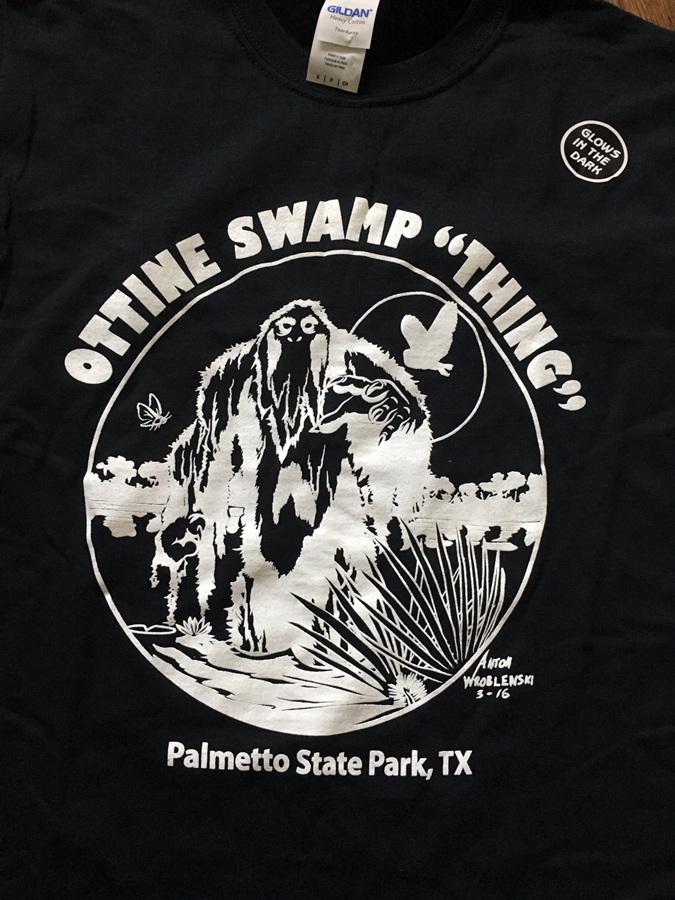
T-shirt design from the Palmetto State Park gift shop
Though I didn’t see any cryptids, monsters, or dinosaurs during my exploration, I thoroughly enjoyed camping and hiking along the beautifully maintained Ottine Swamp Trail. Its spooky tranquility not only offers a refreshing respite, it provides a rare glimpse into a primeval world of the past where the possibility of modern-day mysteries still exists.
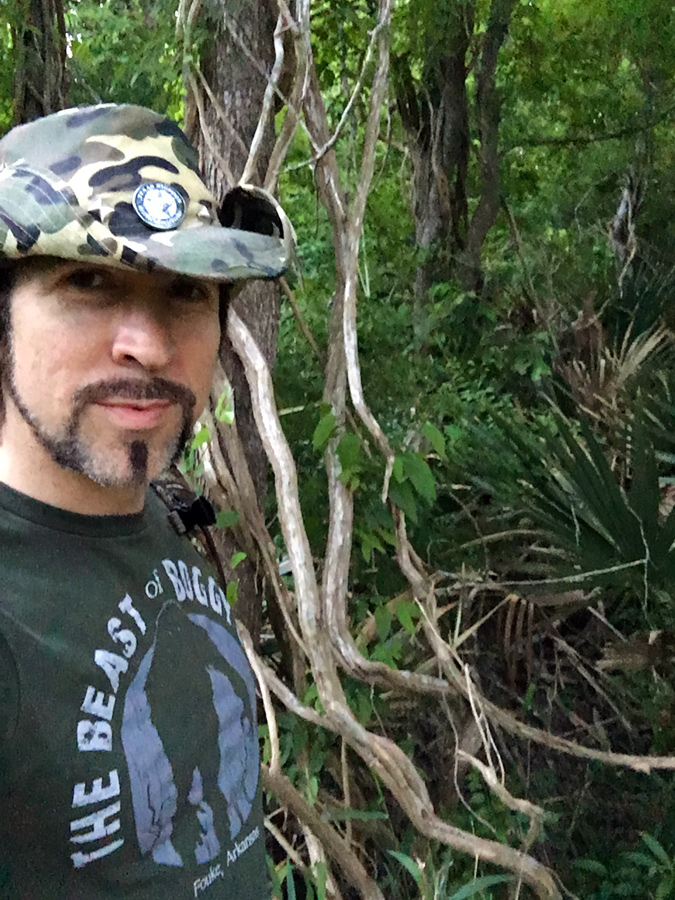
At Ottine Swamp
—————————————————-
Sources: Syers, Ed. Ghost Stories of Texas. Texian Press, 1981.
“Couple has an encounter while hiking in Palmetto State Park.” North American Wood Ape Conservancy.
Don’t Mess With Texas! Monsters, that is…
About Lyle Blackburn
Lyle Blackburn’s research and writing on the subject of legendary creatures and unexplained phenomenon has been widely recognized as some of the best in the field of cryptozoology. His previous books, including The Beast of Boggy Creek and Momo: The Strange Case of the Missouri Monster, offer a balanced view of the subjects while delivering gripping accounts of real-life mysteries.
Lyle is a frequent guest on radio programs such as Coast To Coast AM, and has appeared on television shows such as Monsters and Mysteries in America, Finding Bigfoot, and Strange Evidence. Lyle has also been featured in several award-winning documentary films, including Boggy Creek Monster and The Mothman of Point Pleasant.
For more information, visit Lyle's website at: www.lyleblackburn.com
Filed under Bigfoot, Cryptotourism, Cryptozoologists, Cryptozoology, Monstro Bizarro, Sasquatch, Skunk Apes, Swamp Monsters